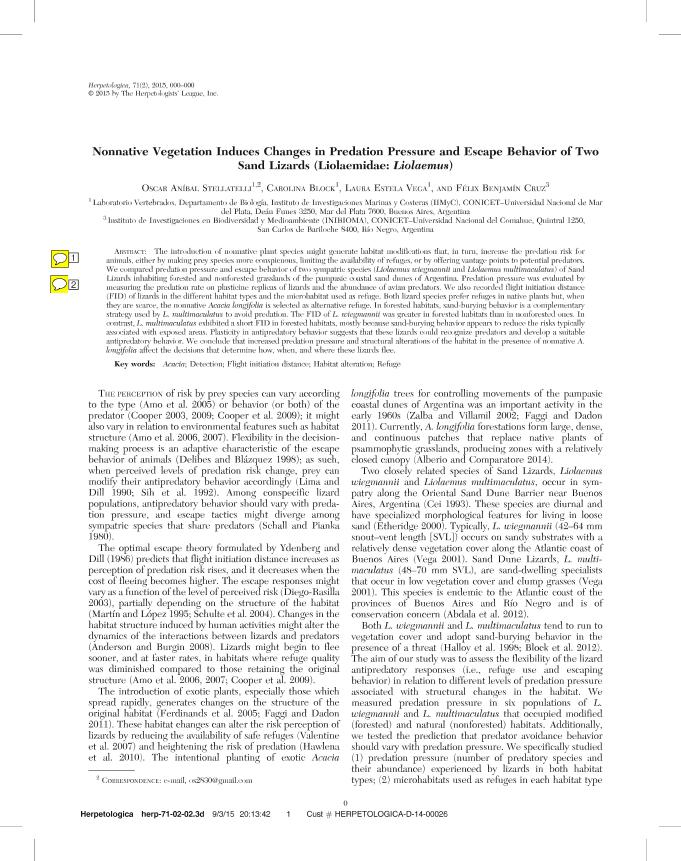Mostrar el registro sencillo del ítem
dc.contributor.author
Stellatelli, Oscar Aníbal

dc.contributor.author
Block, Carolina

dc.contributor.author
Vega, Laura Estela

dc.contributor.author
Cruz, Felix Benjamin

dc.date.available
2018-06-12T16:26:08Z
dc.date.issued
2015-06
dc.identifier.citation
Stellatelli, Oscar Aníbal; Block, Carolina; Vega, Laura Estela; Cruz, Felix Benjamin; Nonnative Vegetation Induces Changes in Predation Pressure and Escape Behavior of Two Sand Lizards (Liolaemidae: Liolaemus ); Herpetologists League; Herpetologica; 71; 2; 6-2015; 136-142
dc.identifier.issn
0018-0831
dc.identifier.uri
http://hdl.handle.net/11336/48328
dc.description.abstract
The introduction of nonnative plant species might generate habitat modifications that, in turn, increase the predation risk for animals, either by making prey species more conspicuous, limiting the availability of refuges, or by offering vantage points to potential predators. We compared predation pressure and escape behavior of two sympatric species (Liolaemus wiegmannii and Liolaemus multimaculatus) of Sand Lizards inhabiting forested and nonforested grasslands of the pampasic coastal sand dunes of Argentina. Predation pressure was evaluated by measuring the predation rate on plasticine replicas of lizards and the abundance of avian predators. We also recorded flight initiation distance (FID) of lizards in the different habitat types and the microhabitat used as refuge. Both lizard species prefer refuges in native plants but, when they are scarce, the nonnative Acacia longifolia is selected as alternative refuge. In forested habitats, sand-burying behavior is a complementary strategy used by L. multimaculatus to avoid predation. The FID of L. wiegmannii was greater in forested habitats than in nonforested ones. In contrast, L. multimaculatus exhibited a short FID in forested habitats, mostly because sand-burying behavior appears to reduce the risks typically associated with exposed areas. Plasticity in antipredatory behavior suggests that these lizards could recognize predators and develop a suitable antipredatory behavior. We conclude that increased predation pressure and structural alterations of the habitat in the presence of nonnative A. longifolia affect the decisions that determine how, when, and where these lizards flee.
dc.format
application/pdf
dc.language.iso
eng
dc.publisher
Herpetologists League

dc.rights
info:eu-repo/semantics/openAccess
dc.rights.uri
https://creativecommons.org/licenses/by-nc-sa/2.5/ar/
dc.subject
Acacia
dc.subject
Detection
dc.subject
Flight Initiation Distance
dc.subject
Habitat Alteration
dc.subject
Refuge
dc.subject.classification
Otras Ciencias Biológicas

dc.subject.classification
Ciencias Biológicas

dc.subject.classification
CIENCIAS NATURALES Y EXACTAS

dc.title
Nonnative Vegetation Induces Changes in Predation Pressure and Escape Behavior of Two Sand Lizards (Liolaemidae: Liolaemus )
dc.type
info:eu-repo/semantics/article
dc.type
info:ar-repo/semantics/artículo
dc.type
info:eu-repo/semantics/publishedVersion
dc.date.updated
2018-05-14T15:08:48Z
dc.identifier.eissn
1938-5099
dc.journal.volume
71
dc.journal.number
2
dc.journal.pagination
136-142
dc.journal.pais
Estados Unidos

dc.journal.ciudad
Lawrence
dc.description.fil
Fil: Stellatelli, Oscar Aníbal. Consejo Nacional de Investigaciones Científicas y Técnicas. Centro Científico Tecnológico Conicet - Mar del Plata. Instituto de Investigaciones Marinas y Costeras. Universidad Nacional de Mar del Plata. Facultad de Ciencia Exactas y Naturales. Instituto de Investigaciones Marinas y Costeras; Argentina
dc.description.fil
Fil: Block, Carolina. Consejo Nacional de Investigaciones Científicas y Técnicas. Centro Científico Tecnológico Conicet - Mar del Plata. Instituto de Investigaciones Marinas y Costeras. Universidad Nacional de Mar del Plata. Facultad de Ciencia Exactas y Naturales. Instituto de Investigaciones Marinas y Costeras; Argentina
dc.description.fil
Fil: Vega, Laura Estela. Consejo Nacional de Investigaciones Científicas y Técnicas. Centro Científico Tecnológico Conicet - Mar del Plata. Instituto de Investigaciones Marinas y Costeras. Universidad Nacional de Mar del Plata. Facultad de Ciencia Exactas y Naturales. Instituto de Investigaciones Marinas y Costeras; Argentina
dc.description.fil
Fil: Cruz, Felix Benjamin. Consejo Nacional de Investigaciones Científicas y Técnicas. Centro Científico Tecnológico Conicet - Patagonia Norte. Instituto de Investigaciones en Biodiversidad y Medioambiente. Universidad Nacional del Comahue. Centro Regional Universidad Bariloche. Instituto de Investigaciones en Biodiversidad y Medioambiente; Argentina
dc.journal.title
Herpetologica

dc.relation.alternativeid
info:eu-repo/semantics/altIdentifier/doi/https://dx.doi.org/10.1655/HERPETOLOGICA-D-14-00026
dc.relation.alternativeid
info:eu-repo/semantics/altIdentifier/url/http://www.bioone.org/doi/10.1655/HERPETOLOGICA-D-14-00026
Archivos asociados
